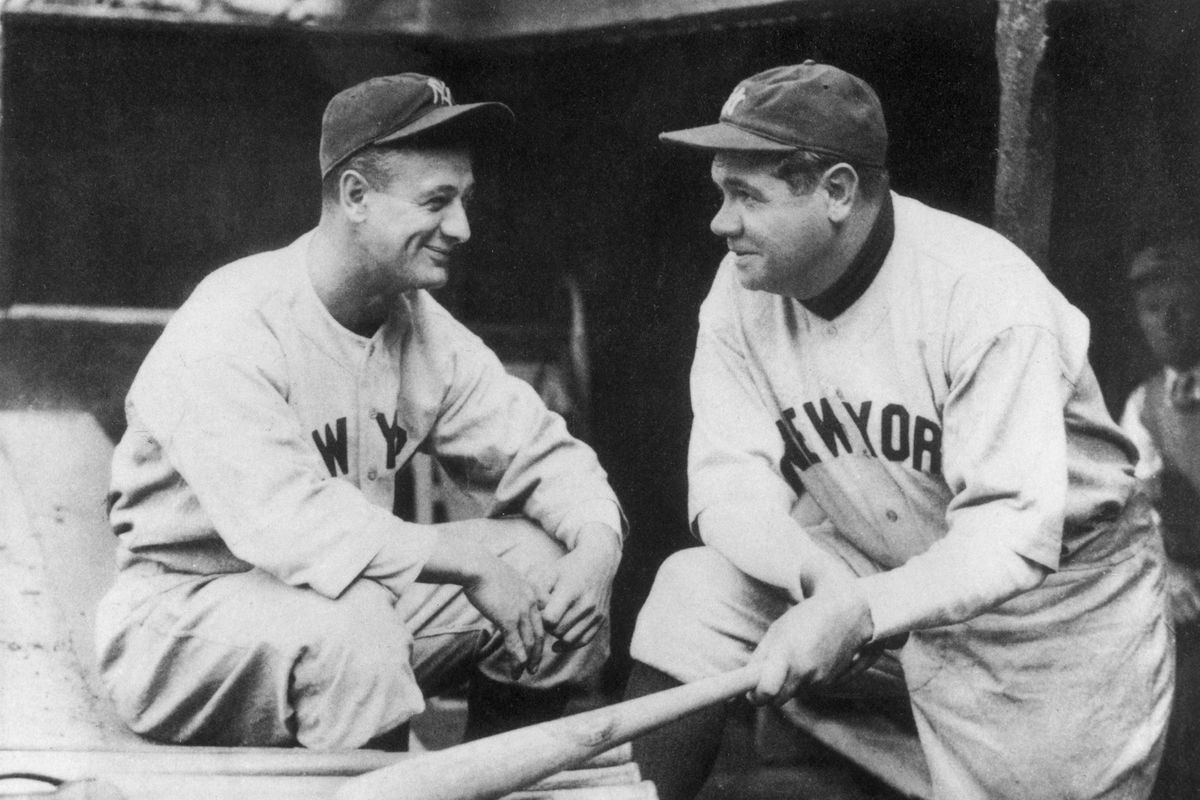Let’s take a walk down history lane, shall we?
The year is 1926. The New York Yankees, once an afterthought, have become a force in the American League after the purchase of Babe Ruth from the Boston Red Sox. Ruth, already a superstar in Boston, went supernova in New York. Brace yourself here. In Ruth’s first five seasons in pinstripes (1920-25), he produced an astronomical OPS+ of 225. 225. The ballclub won its first pennant in ’21, won another in ’22 and won the World Series in ’23. That year, Ruth hit .393/.545/.764.
Yeah.
So why am I starting our journey in 1926? Well, in ’24 the Yankees didn’t win the pennant — Ruth did his part, but other parts of the offense suffered after years of winning. Frankly, that was only the beginning. The ’25 Yankees were terrible, winning only 69 games, in great part due to Ruth missing a big chunk of the season.
However, it wasn’t all bad. You see, in 1925 the Yankees found the other half of what would become the most devastating combination in baseball history. The Bombers already had Ruth, the game’s best player and brightest star. They had reason to believe that when healthy, Ruth would resume smashing every pitcher in baseball.
Those early Ruth teams were generally assembled as so: Ruth carries an offense with a lot of zeroes, while the pitching and defense shortcircuit opponents. From 1921-24, the Yanks had above-average team ERAs and offenses led by the Babe. It was enough, obviously, but it required Ruth to be Ruth. Any dip from the Babe and …
Enter Lou Gehrig. You know the story of Gehrig, right? The Yanks had an entrenched first baseman named Wally Pipp. He was a good player. But, there’s a reason he’s best known as a verb — pipped: to lose your job due to your injury replacement outperforming you — and while there are various versions of the story, Miller Huggins removed him from the lineup and played Gehrig instead.
That was that.
It’s easy in the great span of Yankee history to forget just how absurdly good Gehrig was. His legacy extends beyond the batting averages and homers. The illness. The speech. Rightfully so, of course. Gehrig’s words echo throughout baseball lore.
But man, Lou Gehrig was a force of nature. An absolute force. From 1927-37, Gehrig produced a ridiculous 189 OPS+. And for at least half of those years, he wasn’t even the best player on the team, much less the league.
1926 is pivotal for the Yanks because it sets the table for what was to come in ’27. Ruth, healthy again, hit .372 and bashed 47 homers. Completely established as the starting first baseman, a 23-year-old Gehrig got on-base at a .420 clip and showed the potential for serious power. The Yanks won the pennant but fell to the St. Louis Cardinals in 7. That Cardinal team won only 89 games, led by another superstar of the era, Rogers Hornsby. Bit of an upset.
Hard to say if Ruth, Gehrig and the Bombers went into 1927 looking to avenge the loss, but my goodness did they exact a toll. The ’27 Yankees are fabled now, listed among the greatest teams ever assembled (’75 Reds, ’98 Yankees, etc), and for damn good reason. They won 110 games. They outscored their opponents by 416 runs. Ruth, somehow topping himself, hit .356 and smashed 60 home runs, a new record. Right behind him was the Iron Horse, now a superstar in his own right, hitting .373 with 47 bombs. Waite Hoyt, Herb Pennock and Urban Shocker all had great years on the mound, and the Yanks swept the Pittsburgh Pirates in the World Series.
The Yankees team OPS+ in 1927 was 127. Roger Maris, Rickey Henderson, Don Mattingly and Bill Dickey all had career a OPS+ of 127. That number is flat-out ridiculous.
Oh, and the ERA+? 122. Just get the heck out of here, 1927 Yankees.
In ’28, the Yanks got their revenge on the Cardinals, sweeping them too. The Yanks dual superstars had absurd years yet again; the team didn’t leave quite as much destruction in its wake, but it was enough. The ’29 Yanks suffered from rough pitching and mildly rough years — mildly — from Ruth and Gehrig and didn’t win the pennant.
This started a three-year run of no pennant wins for Bombers, but the night is darkest just before the dawn, isn’t it Master Bruce? The ’32 Yanks, still led by Ruth and Gehrig but joined by a future Hall of Famer in Lefty Gomez on the mound and Bill Dickey behind the plate, defeated the Chicago Cubs in the World Series. This is the series were Ruth called his shot, and it ended up as Ruth’s last appearance in the World Series. He remained roughly as productive as ever in ’33 and ’34, but the decline began to shine through. Age had caught up to him, and his weight had become an issue. He wasn’t moving well.
No one was surprised when the Yankees released him in February of ’35. The time had come, but with it ended an era of baseball.
However, the Yankees weren’t done winning. Still saddled with the Iron Horse, the Bombers had another run in them.
Stay tuned for next week, when I’ll dive into the Gehrig-DiMaggio squads…




